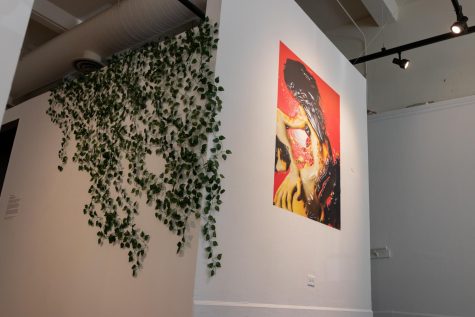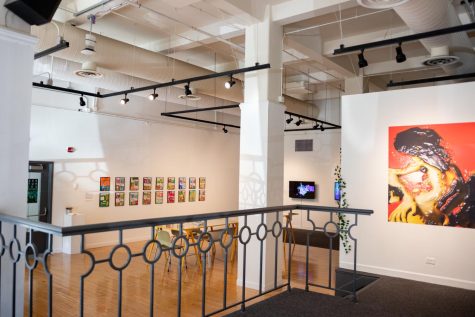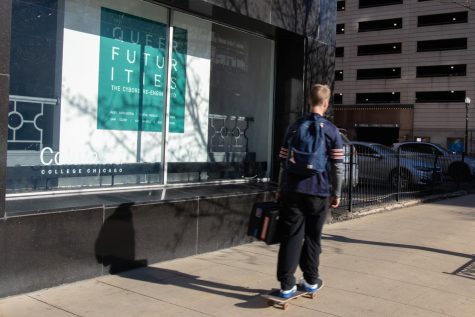‘Queer Futurities’ exhibition explores transgender and gender nonconforming bodies through a futuristic lens
April 18, 2023

“Queer Futurities: The Cyborg Re-engineered” explores work from six contemporary trans and gender nonconforming artists: Abby Lowenstein, Tabitha Nikolai, James Ross, Sam Szabo, Ava Wanbli, and Aleida Zapata.
The collections of work, on display at the Hokin Gallery, 623 S. Wabash Ave., invoke the cyborg to “explore queered notions of gender, embodiment, and identity in a culture mediated by technologies.”
According to their artist statements, Ross and Szbabo analyze heteronormative biases through a satirical lens, while Wanbli and Zapata showcase “personal meditations” that disrupt the fetishization gaze on trans bodies. Lowenstein records first-person archives of queer people among the digital natives, as Nikolai invites attendees into an interactive virtual environment to discover a “far-future” centering the transgender experience.
Sheridyn Villarreal, curator of “Queer Futurities,” said the exhibit’s theme is inspired from research they did towards their art history undergraduate thesis.
Villarreal, who received their bachelor’s in Art History from Columbia in May 2022, said the paper looked at works of art that “evoked the cyborg” as a metaphor for transgender or gender nonconformity.

“With Queer Futurities, the thematic core of these questions and these artists [is] how they’re advancing theories of gender and embodiment,” Villarreal said. “Especially the intersection of art and technology…as we go into a cultural world that technology is evermore embedded in our daily life.”
Wanbli, one of the artists featured in the exhibit, said she wanted to communicate with her past self as well as define her future self with the installation “Sertraline Dolls.”
“Archiving yourself isn’t just about preserving, it’s also about establishing a future for yourself,” Wanbli said.
Presented in a two-channel video installation, “Sertraline Dolls” is a record of Wanbli’s ongoing performance of communicating with avatar proxies of her past selves “in a ritualized expression of sexual consumption.”
Side A contains digitally rendered 3D scans of Wanbli’s body captured over a period of six years, while Side B records a sexual encounter between the artist and a 3D replica of her “boy body” captured several years prior.
Wanbli said that “Sertraline Dolls” is also a “collision of temporalities and desires” as well as a conversation on how people consume transgender bodies.

“We deserve to be three dimensional beings that can be problematic and hurt,” Wanbli said. “And we can also be seen as beautiful, amazing people at the same time…so I tried to mess with these temporalities.”
Wanbli said that in her artistry, she hopes to turn the gaze back onto the people who view her work.
“I hope that people look at this work, and really step inside of themselves to think about their reactions to these stories,” Wanbli said.
Zapata, another artist from the show, said that she wanted to be confrontational with the work she produces.
Her digital sculpture works, “A Dip,” “AI Babes (in ur area)”, and “AmorAmorAmor,” are all on display at “Queer Futurities.”
Frequently modeling figures after her own body, Zapata creates her surreal imagery using 3D software, before abstracting and transforming them into “beings which evade simple designation as either wholly real or unreal, organic or synthetic.”
“I want people to really recognize the position that they’re in when it comes to how we view trans bodies and trans people,” Zapata said. “So much of it is based on our image and this glorification of our quote unquote ‘strength.’”
Zapata said that the show touched on different sides of a possible future, both negative and positive.
“But it kind of feels like an extension of where we are today,” Zapata said. “A lot of queer people are using technology to feel more actualized and so the show just kind of represents, ‘what if we take that idea to its extremes?’”
“Queer Futurities” runs until April 21.







